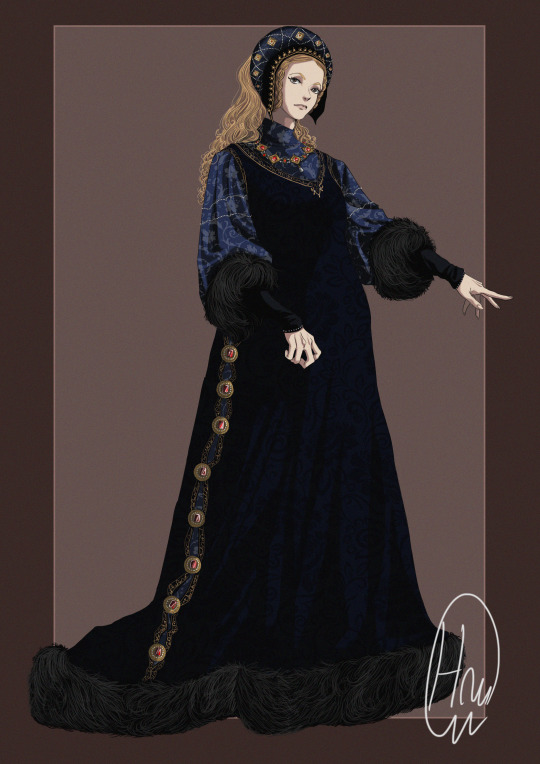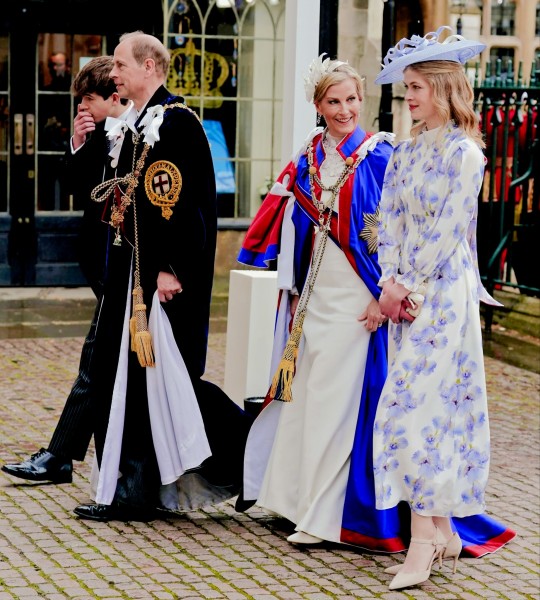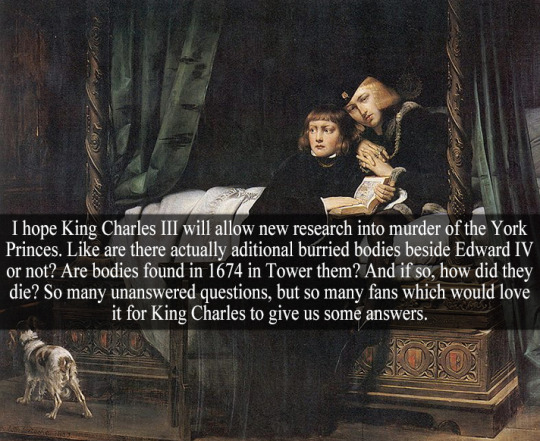#edward iii of england
Text
I’m starting to suspect that GRRM named Alicent Hightower after Alice Perrers, especially if he’s acting on the infamous legend of Edward III’s relationship with her (and Alice generally). It’s obvious, after all, that GRRM took a heavy dose of inspiration for Jaehaerys I from Edward III (albeit less a strictly historical sense of Edward III and more a combination of the general popular idea of him plus that favorite historical fiction grab-bag for GRRM, The Accursed Kings). Like Edward III, Jaehaerys came to the throne as a 14-year-old boy and reigned into his 60s; like Edward III, Jaehaerys succeeded a weak and incapable father to be remembered as a strong and successful king; like Edward III, Jaehaerys was married for over four decades to the (very specifically not beautiful) princess he had wed as a teenager, whom he (supposedly) loved deeply and who represented the beau ideal of medieval/Targaryen queenship; like Edward III, Jaehaerys had a large family but at the end of his life was succeeded not by his much-loved eldest son and heir (nor even his likewise beloved second son), but his most senior grandson. (And this is all without talking about the very obvious comparisons to be made between the Alyssa Velaryon-Rogar Baratheon relationship and regency and that of Queen Isabella and the almost identically named Roger Mortimer.)
So it may have been only natural that GRRM would extend the parallel by naming Alicent after Alice Perrers, who became the mistress of Edward III at some point in the mid 1360s. Would it surprise anyone if GRRM believed, as has been long assumed, that Alice was a young teenager when she became a member of the royal household and the lover of the elder king - perhaps, indeed, the same age as the 15-year-old Alicent was when, having entered the royal household as the daughter of the Hand, she was reading to the elderly and dying Jaehaerys I? Would it surprise anyone if GRRM thought of Alice - widely (if not totally accurately) remembered as grasping and ambitious, manipulating a supposedly feeble and senile king into dumping lands, treasurers, and gold almost literally into her lap - in creating Alicent - a girl whose father (who certainly did not lack for ambition) would later be accused of bringing her to court expressly to win over the future King Viserys I, and who herself would be rumored to have had a sexual relationship with the both aged Jaehaerys as well as the then-married Viserys (perhaps echoing how Alice’s relationship with Edward began while Philippa was still alive)? If Alice is far from a perfect parallel to Alicent (and there are definitely significant differences between the two), I can nevertheless believe GRRM liked the idea of borrowing some surface-level elements of Alice - including, most basically, a version of her name - to use for Alicent Hightower.
#asoiaf meta#alicent hightower#jaehaerys i targaryen#historical parallels#real world inspiration#alice perrers#Edward iii of England
72 notes
·
View notes
Text

A Conservator adjusts the gallery clock in St George’s Hall at Windsor Castle.
The ceiling above is studded with the coats of arms of all the Knights of the Garter since the foundation of the Order in 1348.
29 October 2023
—
The Most Noble Order of the Garter is an order of chivalry founded by Edward III of England in 1348.
It is the most senior order of knighthood in the British honours system. The only decorations which outrank it in precedence are the Victoria Cross and the George Cross.
The Order of the Garter is dedicated to the image and arms of Saint George, England's patron saint.
#St George’s Hall#Windsor Castle#Knights of the Garter#gallery clock#coats of arms#clock#clock change#Royal Collection Trust#British Royal Family#Most Noble Order of the Garter#Order of the Garter#Edward III of England#Saint George#British honours system#knighthood
12 notes
·
View notes
Photo

(Jean Fouquet, Isabella of France landing in England with her son, the future Edward III in 1326, c. 1460)
#jean fouquet#international gothic#isabella of france#edward iii of england#house of capet#house of plantagenet#medieval#art#art history
16 notes
·
View notes
Text
My Hundred Years War Causes Series
The Hundred Years War did not just begin as a dynastic dispute which left the throne of France having multiple claimants with the death of Charles IV of France, the last male of the mainline of the Capet dynasties, in 1328.
The Hundred Years War did not just begin as a dynastic dispute which left the throne of France having multiple claimants with the death of Charles IV of France, the last male of the mainline of the Capet dynasties, in 1328.
The driving forces behind this conflict were geopolitical, historical, and dynastic disputes over the succession and the expansion of Capet’s dynastic power in France during…

View On WordPress
#100 years war#Edward I of England#Edward III of England#History#Philip II of France#Scottish History
0 notes
Text

Elizabeth of York, fashion character design. Mourning outfit, c. 1482.
#the wars of the roses#15th century#medieval#middle ages#historical#british history#medieval england#art#illustration#sketch#edward iv#elizabeth woodville#elizabeth of york#henry vii#henry vi#margaret of anjou#margaret beaufort#isabel neville#richard iii#the white queen#the white princess#medieval fashion#historical fashion#character design#artists on tumblr#medieval costume#royals#house of york#plantagenets
261 notes
·
View notes
Text

Something I had done years ago on A4 size paper. I think I skipped a few due to lack of space. Kings and Queens of England (after king Henry IV)
#kings of england#artists on tumblr#drawing#traditional art#traditional drawing#Richard III#Henry VII#Henry VIII#Mary I#Elizabeth I#Charles I#Charles II#George III#George IV#Queen Victoria#George v#George VI#Edward VII#queen elizabeth ii#history art
718 notes
·
View notes
Text

#hundred years war#art#medieval#middle ages#france#england#knights#knight#soldiers#soldier#armour#banner#standard#pennant#history#europe#european#english#french#edward iii#philip vi#john the good#john ii#jean le bon#philippe de valois#edouard iii d'angleterre#battle of crécy#battle of poitiers#warfare#battle
34 notes
·
View notes
Photo








↳ richard iii of england + alphabet
#richard iii#aneurin barnard#the white queen#house york#house plantagenet#history#english history#twq#richard iii of england#anne neville#cecily of york#edward iv#george plantagenet#elizabeth woodville#richard of york#henry vii#margaret of york#john de la pole#historyedit#twqedits*#alphabet*#my gifs#creations*
376 notes
·
View notes
Note
What do you feel about the house of york
I feel like it's a medieval dynasty that one a war. That's about it.
I also think that Richard Duke of York was nothing more than a jealous cousin that saw the perfect opportunity to climb the ladder and took it, justly paying the price. Edward IV's anger over his and his brother's death is understandable and so were his actions. Too bad that he didn't saw that the Duke of York's ruthless ambitions had trickled down to his sons Richard and George before they tried it with him. I think the Woodvilles were overtly greedy and took too much of the hand that fed them making the nobility hate them, and they also paid for it. I mean, arranging prestige marriages for every single Woodville? I get it, one of them was the Queen, but come on now, they clearly overplayed.
On the whole, I find this representation of the Yorks as this typical Good HeirsTM that took their rightful place on the throne and stepped up through harsh times that persists so much to this day lame and reductive. The truth of the matter is, they were never more just and GoodTM than the Lancasters. The Lancasters successfully organized a coup and sat the throne, the Yorks did the same, demonizing Henry VI and Queen Margaret of Anjou through propaganda as a freak and an overly ambitious femme fatale respectively, while casting their teenage son as a cruel bastard. All for defending fiercely what was by right theirs (we have Shakespeare to blame for that as well).
#wars of the roses#house york#house lancaster#edward iv#richard duke of york#george plantagenet#richard iii#Henry vi#margaret of anjou#edward of westminster#medieval warfare#medieval england#late middle ages
27 notes
·
View notes
Photo





God Save the King !
King Edward VII ✧ 24 January 1901
King George V ✧ 9 May 1910
King Edward VIII ✧ 21 January 1936
King George VI ✧ 12 December 1936
King Charles III ✧ 10 September 2022
#royaltyedit#historyedit#king charles iii#king edward vii#king george v#edward viii#king george vi#england#my edits#gif
463 notes
·
View notes
Text
Elizabeth of York being that iconic that every man who ever met her immediately fell in love with her, she was the darling of her father Edward IV’s eye, had her Uncle Richard III wrapped around her finger and then married her families enemy Henry VII in an arranged marriage but managed to get him to fall head over heals for her. To the point where he was on the short list of Kings in history who never took a mistress, remained loyal to her and is documented as being so depressed and suicidal after her death that he was never the same, and then her son who even though he became such a horrendous man he spent his entire life trying to replace his mother with every woman he met.
29 notes
·
View notes
Text
"In the early 1360s Edward III took as his mistress Alice Perrers, the daughter of a London goldsmith and widow of one of the King’s jewellers, Janyn Perrers. Alice’s opponents would later viciously exaggerate her low birth—Thomas Walsingham claimed that her father was a thatcher—so it has only been in this century that her true identity was revealed by Mark Ormrod and Laura Tompkins. Alice became one of Philippa’s demoiselles, but supplemented her income from Philippa with a role as a moneylender to merchants and gentry. During Philippa’s lifetime she began investing her wealth in property that, Tompkins has estimated, would eventually approach £2000 per annum in value—an income that exceeded that of some earls.
Alice bore the King a son, John Southeray, in about 1365 and from 1367 she received a number of royal grants. Her name is notably absent from the list of Philippa’s ladies who received bequests in the Queen’s will. Philippa died in 1369 and, unlike other widowed kings of the later Middle Ages, Edward III seems to have made no attempt to look for a replacement queen. Alice then emerged as a public figure, richly rewarded by the King, and sought out by courtiers for her influence over him. In 1373 Edward gave her a collection of the queen’s jewels and the following year the Pope himself included her among those he petitioned to influence Edward III to engineer his brother’s freedom from captivity. Alice subsequently stole the show at a royal tournament at Smithfeld when she dressed as “the Lady of the Sun.” Her choice of outft was probably a deliberate spin on Edward III’s own sunburst emblem.
Alice was indubitably a skilled businesswoman with an impressive grasp of property law, but she was also abusing her closeness to the King in order to build up her wealth. Moreover, contemporaries identifed her as the heart of a disruptive and malign court clique. Tompkins has argued that Alice’s powerful and self-serving influence over the King was perceived as “inverting queenship.” During the Good Parliament of 1376, Alice was condemned for the use of maintenance, accused of taking thousands of pounds from the Exchequer, and ordered to stay away from the court, under threat of banishment.
Thomas Walsingham reported that at this time her accomplice in seducing the King was also arrested, a Dominican friar who was an “evil magician” and had used wax effgies of the King and Alice to enable her to “get whatever she wanted from the King.” There is no corroborating evidence for this story of arrest, but the idea that low status women could only attract the admiration of kings or nobles through witchcraft was a pervasive one, especially apparent in Elizabeth Woodville’s story [...], and probably also in that of a later quasi-queen, Eleanor Cobham [...].
Just months after the Good Parliament, the King had pardoned Alice, but he died the following year. At some point in the 1370s she had taken a second husband, Sir William Windsor, who spent most of his career in Ireland. In the autumn of 1377, Alice was accused of having persuaded Edward III to countermand an order to investigate charges against Windsor the previous year and to pardon one of her business associates. Alice was sentenced to banishment and forfeiture of all goods and lands. Although this banishment was revoked in 1379, her subsequent attempts to regain her possessions were consistently frustrated. She died in the winter of 1401–1402, bequeathing her “usurped” lands to her two daughters by the King. Their son had predeceased her.
Unlike the later quasi-queens, Alice’s position came from sharing a king’s bed and was thus closer to that of an actual consort. By contrast, her low social status and ineligibility to produce an heir to the throne made her less like a queen consort than her successors. She was thus better physically positioned to exert influence but ideologically wholly separated from any authority to do so."
J.L Laynesmith and Elena Woodacre, "The Later Medieval English Consorts: Power, Infuence, Dynasty", "Later Plantagenets and Wars of the Roses Consorts"
#she 💜#historicwomendaily#alice perrers#edward iii#i guess#14th century#english history#the way people talk about her is so disgusting#imagine thinking that a teenage commoner 'seduced' or 'took advantage of' the 50+ year King of England#my post
46 notes
·
View notes
Text


The Duke and Duchess of Edinburgh, Lady Louise Mountbatten-Windsor and James Mountbatten-Windsor, Earl of Wessex attend King Charles III and Queen Camilla's Coronation, at Westminster Abbey in London, England -May 6th 2023.
#prince edward#duke of edinburgh#duchess of edinburgh#lady louise#lady louise mountbatten windsor#james mountbatten windsor#earl of wessex#british royal family#england#2023#may 2023#coronation#king charles iii and queen camilla's coronation#king charles iii's coronation#royal children#my edit
120 notes
·
View notes
Text
In the tumultuous world of medieval England, Edward IV was a king who fought tooth and nail to secure his place on the throne amidst a sea of betrayal and bloodshed. His rise to power during the Wars of the Roses shaped the destiny of a nation.
10 notes
·
View notes
Text

“I hope King Charles III will allow new research into murder of the York Princes. Like are there actually aditional burried bodies beside Edward IV or not? Are bodies found in 1674 in Tower them? And if so, how did they die? So many unanswered questions, but so many fans which would love it for King Charles to give us some answers.” - Submitted by Anonymous
21 notes
·
View notes
Text

Elizabeth of York, fashion character design c. 1473-1474.
If you dare to think that I have developed some kind of obsession with little Elizabeth of York, I must tell you...
… you are right.
P.S. My mom told me she looks like a historical Tinkerbell and now I can't stop thinking about it lol
#the wars of the roses#15th century#historical#medieval#british history#medieval england#art#illustration#sketch#edward iv#elizabeth woodville#elizabeth of york#henry vii#henry vi#margaret of anjou#margaret beaufort#isabel neville#richard iii#the white queen#the white princess#medieval fashion#historical fashion#character design#artists on tumblr#medieval costume#royals#house of york#plantagenets
255 notes
·
View notes